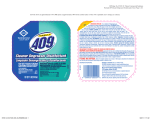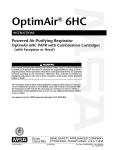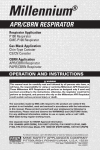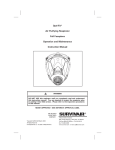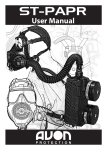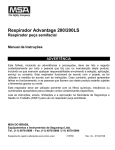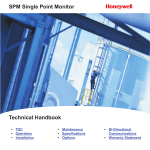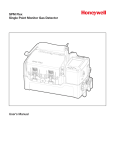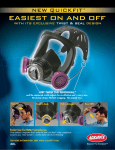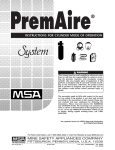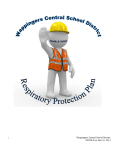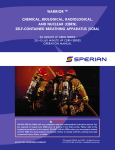Download Instruction Manual
Transcript
818365.qxd 11/3/98 10:40 AM Page 1 low maintenance respirator instructions This booklet, including the warnings and cautions inside, must be read and followed carefully by all persons who use or maintain this product, including those who have any responsibility involving its selection, application, service or repair. This respirator will perform as designed only if used and maintained according to the instructions. Otherwise, it could fail to perform as designed and persons who rely on this product could sustain serious personal injury or death. See inside for instructions, warnings, and cautions and limitations. For additional information, call 1-800-MSA-2222 during regular working hours, or 1-800-MSA-5555 after working hours or during emergencies. See separate insert for NIOSH approval information. 818365.qxd 11/3/98 10:40 AM Page 2 the same cartridges or filters) if the mixture meets the following conditions: a. The cartridge/filter must be approved for all contaminants present. b. NIOSH permits mixing of the following contaminants: Organic vapors, sulfur dioxide, chlorine, ammonia, methylamine, chlorine dioxide, hydrogen sulfide, and hydrogen chloride. c. Particulates can be mixed with any other particulate or any gas or vapor for which the cartridge is approved. d. Contaminants present simultaneously must be below IDLH levels for the specific contaminants. If any one contaminant in the mixture exceeds the IDLH concentration, then the entire mixture must be treated as IDLH and the respirator cannot be used (except for escape from particulates with the appropriate filter). e. Mersorb-P100 cartridges can be used against a mixture of chlorine and mercury that are both present simultaneously, but cannot be used if alternating between mercury-contaminated atmospheres and chlorine-contaminated atmospheres. TABLE OF CONTENTS NIOSH APPROVAL INFORMATION Cautions and Limitations . . . . . . . . . . . . . . . . . 2 SPECIAL USER INSTRUCTIONS . . . . . . . . . . . . 2 Mixture of Contaminants . . . . . . . . . . . . . . . 2 Time Use Limitation . . . . . . . . . . . . . . . . . . . . . 2 RESPIRATOR USE LIMITATIONS . . . . . . . . . . . 3 EXPOSURE LIMITS . . . . . . . . . . . . . . . . . . . . . . 3 Exposure Limits for Mixtures. . . . . . . . . . . . 3 RESPIRATOR FIT TEST . . . . . . . . . . . . . . . . . . . 3 Quantitative Test. . . . . . . . . . . . . . . . . . . . . . 3 Qualitative Test . . . . . . . . . . . . . . . . . . . . . . . 3 DESCRIPTION (Full Facepiece Respirator). . . . 4 PREPARATIONS FOR DONNING . . . . . . . . . . . 4 Attaching Filter Cartridges . . . . . . . . . . . . . . 4 DONNING THE RESPIRATOR . . . . . . . . . . . . . . 4 TEST FOR TIGHTNESS . . . . . . . . . . . . . . . . . . . 5 REPLACING FILTERS/CARTRIDGES . . . . . . . . . 5 CLEANING AND DISINFECTING . . . . . . . . . . . . 5 MAINTENANCE . . . . . . . . . . . . . . . . . . . . . . . . . 6 Installing a Nosecup . . . . . . . . . . . . . . . . . . . 6 Installing an Outsert Lens . . . . . . . . . . . . . . 6 NIOSH APPROVAL INFORMATION Cautions and Limitations A- Not for use in atmospheres containing less than 19.5 percent oxygen. B- Not for use in atmospheres immediately dangerous to life or health. C- Do not exceed maximum use concentrations established by regulatory standards. H- Do not wear for protection against organic vapors with poor warning properties or those which generate high heats of reaction with sorbent. J- Failure to use and maintain this product properly could result in injury or death. L- Follow the manufacturer’s User Instructions for changing cartridges and/or filters. M- All approved respirators shall be selected, fitted, used, and maintained in accordance with MSHA, OSHA and other applicable regulations. N- Never substitute, modify, add, or omit parts. Use only exact replacement parts in the configuration as specified by the manufacturer. O- Refer to User Instructions, and/or maintenance manuals for information on use and maintenance of these respirators. P NIOSH does not evaluate respirators for use as surgical masks. S- Special or critical user instructions and/or specific use limitations apply. Refer to User Instructions before donning. Mersorb-P100 respirators utilize an endof-service-life indicator for use against metallic mercury vapor. The band around the side of each Mersorb-P100 cartridge, consists of chemically-treated paper. In use, as the paper is exposed to metallic mercury vapor, it changes from orange to brown. When the indicator color changes to brown, the cartridge is beginning to lose its effectiveness against metallic mercury vapor and must be replaced. Thus, the wearer has a constant, positive check on the condition of his cartridge. Time Use Limitation N- and R- series filters shall be limited to 8 hours of use (continuous or intermittent against particulates). [Service time can be extended by performing an evaluation in the specific workplace setting that demonstrates (a) that the extended use will not degrade the filter efficiency below 95% or (b) that the total mass loading of each filter is less than 100 mg.] 1. This respirator must be used in conjunction with the proper chemical or particulate cartridges for protection against specific contaminants. 2. Leave area immediately if: a. Breathing becomes difficult; b. Dizziness or other distress occurs; c. You taste or smell contaminant; d. You experience eye, nose or throat irritation. SPECIAL USER INSTRUCTIONS Mixture of Contaminants NIOSH allows this respirator to be used for protection against a mixture of contaminants that are present simultaneously, or alternately, against one contaminant then another (using 2 TAL 8901 (L) Rev. 1 - 818365 818365.qxd 11/3/98 10:40 AM Page 3 Exposure Limits for Mixtures The American Conference of Governmental Industrial Hygienists (ACGIH) publishes the following information to determine the TLV of a mixture. First determine the total concentration of the chemical mixture (CMixture) from the individual contaminant concentrations (C1, C2, C3, ...) using the following formula: 3. Use strictly in accordance with instructions, labels and limitations pertaining to this device. 4. This respirator may not provide a satisfactory seal with certain facial characteristics, such as beards or large sideburns, that prevent direct contact between the skin and the sealing surface of the facepiece. Do not use this facepiece if such conditions exist. 5. This respirator is for use by trained and qualified personnel only. Failure to follow these precautions can result in serious personal injury or death. CMixture = C1 + C2 + C3 + ... The TLV of the mixture is found by using the following formula where T1, T2, T3, ... are the individual contaminant TLVs and C1, C2, C3, ... are the individual contaminant concentrations. RESPIRATOR USE LIMITATIONS The wearer must comply with the following MSA respirator use limitations: 1. MAXIMUM USE CONCENTRATION— Do not exceed any of the following: a. 100 times the exposure limit for the contaminants present, except during escape only from particulates with an approved filter cartridge. b. Immediately dangerous to life or health (IDLH) concentration for any contaminant present. 2. Do not wear for protection against the following contaminants. This far-from-complete list is offered only as a guide to proper evaluation of the many contaminants found in industry. Contact MSA for further information on other specific material. Acrolein Aniline Arsine Bromine Carbon monoxide Diisocyanates Dimethylaniline Dimethyl sulfate Hydrogen cyanide Hydrogen selenide Methanol Methyl bromide Methyl chloride Methylene chloride Nickel carbonyl Nitric Acid TMixture = C C + 2 + 3 +... T1 T2 T3 Only use these equations if the contaminants present are actually mixed. Some substances do not mix and may be present separately, for example, in pockets or at different levels. In that case, the lowest TLV of the substances present must be used to determine the appropriate respirator category for protection against all contaminants present. See MSA’s Response Respirator Selector for additional information. RESPIRATOR FIT TEST Nitro compounds: Nitrogen oxides Nitroglycerin Nitromethane Ozone Phosgene Phosphine Phosphorous trichloride Stibine Sulfur chloride Urethane or other diisocyantecontaining paints Vinyl chloride A qualitative or quantitative respirator fit test must be carried out for each wearer of this respirator to determine the amount of protection it will provide. Respirator fit tests are explained fully in the American National Standard for Respiratory Protection, ANSI Z88.2, which is published by the American National Standards Institute, 11 West 42nd Street, New York, New York, 10036. Quantitative Test — If a quantitative fit test is used, a fit factor that is at least 1000 shall be obtained before that respirator is assigned to an individual. EXPOSURE LIMITS Qualitative Test — If a qualitative fit test is used, only validated protocols are acceptable. The individual must pass a test designed to assess a fit factor of at least 1000. A listing of acceptable exposure limits from the following sources is provided in the Response® Respirator Selector from MSA: — American Conference of Governmental Industrial Hygienists (ACGIH) — Occupational Safety and Health Administration (OSHA). — National Institute for Occupational Safety and Health (NIOSH) — American Industrial Hygiene Association (AIHA) Contact MSA at 1-800-MSA-2222 for information. TAL 8901 (L) Rev. 1 - 818365 CMixture C1 The user must perform a respirator fit test and follow all warnings and limitations specified. Failure to do so can result in serious personal injury or death. 3 818365.qxd 11/3/98 10:41 AM Page 4 DONNING THE RESPIRATOR DESCRIPTION (Full Facepiece Respirator) The Advantage 1000 Respirator is an air purifying respirator which includes a full facepiece assembly and a pair of air purifying elements to provide respiratory protection against hazardous vapors, gases and/or particulate matter. When the wearer inhales, the contaminated air is drawn through the air-purifying elements, and depending on the elements used, removes the hazardous vapors, gases and/or particulate matter. The inhalation valves open and the exhalation valve remains closed to prevent contaminated air from entering the facepiece. During exhalation, the exhalation valve opens, and the inhalation valves close to prevent exhaled air from passing back through the air purifying elements. The exhalation valve permits exhaled air to exit from the respirator. To put on the respirator: a. Adjust the facepiece headstraps so the end tabs are at the buckles. (see fig. 1) figure 1 b. Grip the facepiece between the thumb and fingers with both hands. Insert your chin into the chin cup. (see fig. 2) c. Pull the facepiece headstraps over your head. Smooth the figure 2 straps flat against your head. d. Support the facepiece by holding the speaking diaphragm housing with one hand. e. To tighten the lower (neck) straps, pull the straps straight figure 3 back, not out. f. Tighten the side (temple) straps. (see fig. 3) g. Adjust the forehead straps if needed to position the lens for best vision. h. Perform the Test for Tightness Test. Note An air-supplied (air-line) kit is available for this respirator (P/N 10003601). PREPARATIONS FOR DONNING The following inspection points must be checked before donning the respirator. A respirator that fails the inspection must not be used. The respirator must be repaired or replaced. 1. Head Harness: Check to see that the head harness straps still have their elasticity. Inspect for breaks or tears and make sure all adjusters are in place and working properly. 2. Facepiece: Check facepiece for dirt, cracks, tears or holes. Inspect the shape of the facepiece for possible distortion that may occur from improper storage and make sure the rubber is flexible, not stiff. Also check for cracks. 3. Inhalation and exhalation valves: Check for cracks, tears, distortion, dirt or build-up of material between valve and valve seat. 4. Cartridge connectors: Check to make sure connectors are in place and check for cracks and damage. 5. Cartridges and filters: Make sure cartridges and filters are clean. Never try to clean a cartridge or filter by washing it or using compressed air. Inspect cartridges for scratches, cracks or other damage, particularly the sealing bead around the bottom. Note A nosecup accessory is available to reduce lens fogging. If the respirator will be used in areas of high humidity, or at temperatures below 32°F, the nosecup accessory may be installed. See page 5. Do not wear conventional eyeglasses with a full facepiece. The temple bars pass through the sealing surface of a full facepiece and prevent a seal. Use the spectacle kit from MSA. Failure to follow this precaution may result in serious personal injury or death. Attaching Filter Cartridges Carefully attach filter cartridges to facepiece connectors by first aligning the cutouts on the cartridges with the lugs on the facepiece connectors and then turning the cartridge clockwise by hand until tight. Align the small lug on the connector with the match-mark located on the cartridge body. (See Replacing Cartridges.) 4 TAL 8901 (L) Rev. 1 - 818365 818365.qxd 11/3/98 10:44 AM Page 5 REPLACING FILTERS/CARTRIDGES NEGATIVE PRESSURE METHOD The following conditions indicate that the cartridges have served their useful life and must be replaced: Chemical Cartridges: Odor or taste of gases or vapors; eye, nose, or throat irritation. Filter Cartridges/Snap-On Filters: Excessive breathing resistance when inhaling or when time use limitation has been reached. Combination Cartridges: Either of the above conditions. Brown color on end-of-service life indicator (Mersorb® Cartridges only). POSITIVE PRESSURE METHOD TEST FOR TIGHTNESS Test for Tightness Before Each Use By One of the Following Methods: • Negative Pressure Method — Place your palms over cartridges lightly. Gently inhale so that the facepiece collapses slightly and hold breath for ten seconds. The facepiece will remain collapsed while the breath is held, unless there is a leak in the seal. • Positive Pressure Method — Place your palm over exhalation valve cover lightly. Gently exhale so that a slight positive pressure builds up inside the respirator and hold breath for ten seconds. The positive pressure will remain while the breath is held, unless there is a leak in the seal. If any leakage is detected around the facial seal, readjust head harness straps and repeat test until there is no leakage. If other than facial seal leakage is detected, the condition must be investigated and corrected before another test is made. The respirator must pass one of the above tightness tests before the respirator is used. The respirator will not furnish protection unless all inhaled air is drawn through suitable cartridges. To replace cartridges: 1. Remove the expended cartridges and dispose of properly. 2. Remove the replacement cartridges from storage bags. 3. Place cartridges on connectors carefully. Line up match-mark on cartridge with small lug on connector (on facepiece).Make sure cartridge connector lugs align with the cartridge opening. Push down and tighten cartridge clockwise until the stops are engaged. To ensure a good seal against the facepiece, tighten each cartridge by gripping as much of the circumference of the cartridge as possible and then slowly turning the cartridge until tight. CLEANING AND DISINFECTING If the facepiece is to be cleaned, remove the cartridges. The facepiece (with the cartridges removed) should be cleaned and disinfected after every use with Cleaner-Disinfectant Liquid from MSA (P/N 697284). 1. Prepare a solution of Cleaner-Disinfectant Liquid and water, following the instructions on the Cleaner-Disinfectant container. Do not enter any atmosphere with this respirator unless you know that: 1. You have read, understood and followed all instructions and warnings pertaining to the respirator. 2. The respirator and conditions meet the requirements outlined. 3. The cartridges are the proper type for the contaminant or contaminants present. 4. The amount of oxygen is sufficient to support life (that is, at least 19.5 percent oxygen by volume at sea level). Do not use if oxygen concentration sufficient to support life is questionable. 5. Respirator does not leak (see test for tightness). 6. Cartridges do not need to be replaced. Discard exhausted cartridges. 7. You are not color blind and can distinguish between the beginning and ending colors of the end-of-service-life indicator (when using Mersorb-P100 respirators only). Failure to follow the above warnings can result in serious personal injury or death. TAL 8901 (L) Rev. 1 - 818365 2. Immerse soiled equipment in the solution and scrub gently with a soft brush until clean. Take care to clean the exhalation valve in the facepiece and all other parts that exhaled air contacts. 3. After the equipment has been immersed for the time specified on the CleanerDisinfectant Solution container, rinse thoroughly in plain warm water (maximum 120°F) and then air-dry. 5 818365.qxd 11/3/98 10:45 AM Page 6 Cleaning and disinfecting at or below 120°F temperature will avoid possible overheating and distortion of parts of the respirator assembly, which would necessitate replacement. MAINTENANCE This respirator must be kept in good condition to function properly. When any respirator shows evidence of excessive wear or damage, it must be replaced immediately. Refer to the Preparations for Donning section for proper inspection of the respirator. This respirator, when not in use, should be stored in a clean dry location, such as its storage bag. Do not distort rubber facepiece during storage. Installing a Nosecup The nosecup assembly is to be placed onto the exhalation valve lugs inside the mask. The larger hole surrounded by 3 smaller holes at the bottom of the nose cup is to be used. 1. Push the exhalation valve/voicemitter area out through the back portion (face seal area) of the mask. Push until this portion of the mask becomes inverted and the wings of the exhalation valve are exposed and can freely accept this nosecup. 2. Bend the intern mask sealing lip away from the exhalation valve for easier installation. 3. Slide the larger lower nosecup hole over one of the wings of the exhalation valve. A mild soap solution can be used to aid in the installation and alignment process. TAL 8901 (L) Rev. 1 4. Stretch the nosecup over the other exhalation valve wing. 5. Orient the nosecup in the facepiece by rotating it around the exhalation valve. Use the respirator voicemitter and facepiece intern lip for locating and aligning the nosecup. 6. Return the facepiece to its original noninverted position. Inspect the intern lip positioning of the facepiece to assure that the nosecup is underneath the lip and in the correct location. Now use the facepiece in the normal instructed manner. Installing an Outsert Lens Remove the outsert lens from the packaging. Place the two hook lugs at the top of the outsert lens over the top of the mask lens edge. Center the outsert lens on the mask. Next stretch the elastic retainer band (located at the bottom of the outsert lens) over the voicemitter housing and seat it under the voicemitter retainer flange. The respirator can be used in the normal prescribed manner. © MSA 1998 818365






